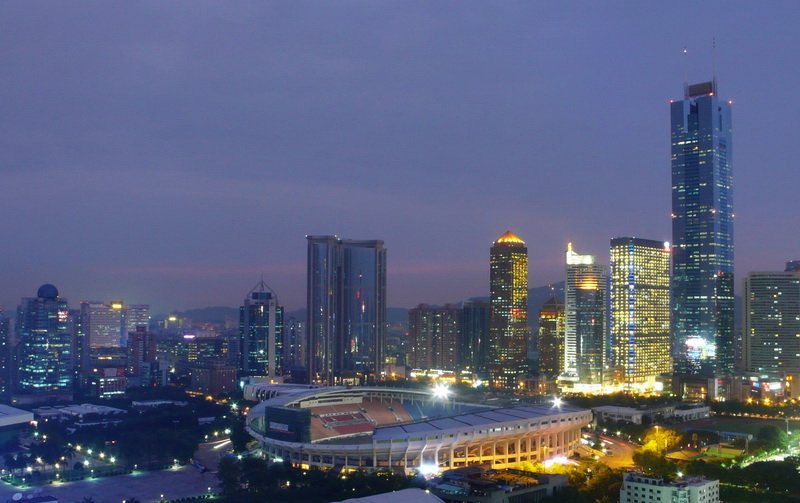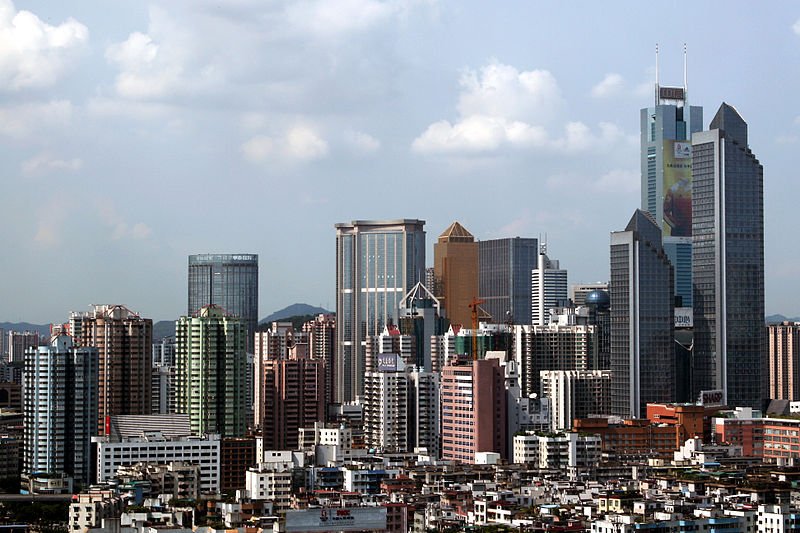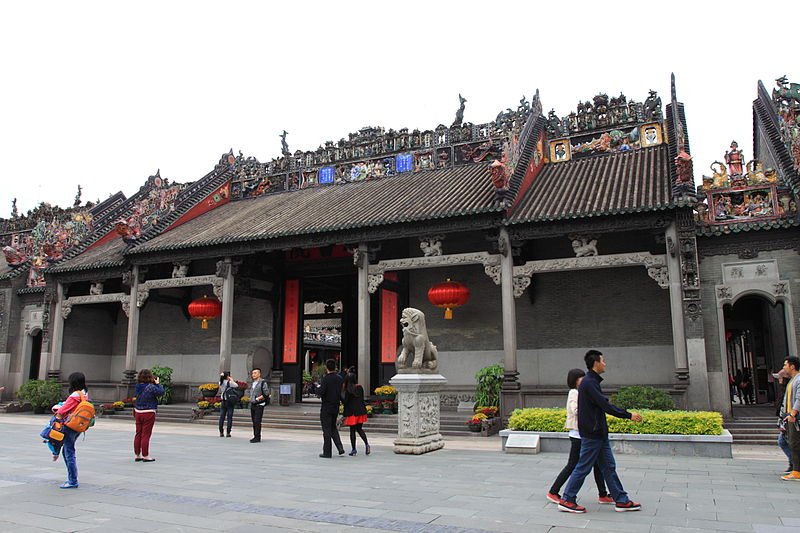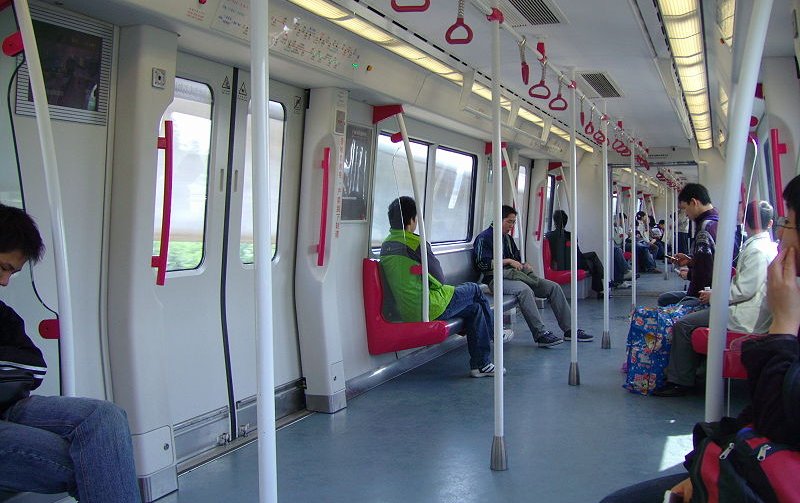 Guangzhou at dusk
Guangzhou at duskSource: https://en.wikipedia.org/wiki/File:Guangzhou_dusk_11-5-2008.png
Author: Myouzke

Guangzhou is the biggest city and provincial capital of Guangdong Province, China. In fact, it ranks third behind Shanghai and Beijing in terms of population as well as land area. As of 2000, the city of Guangzhou has a population of 6 million people. It is located within a metropolitan area with a population of 12 million. The entire urban sprawl of Guangzhou has as many as 24 million people, making it the second biggest urban area in the world behind Tokyo.
Guangzhou (广州) was formerly known in English as Canton, from which we get the dialect Cantonese. It is also known as Kwangchow.
 Tianhe District, Guangzhou, China
Tianhe District, Guangzhou, China
Author: Myouzke

Guangzhou is the biggest city and provincial capital of Guangdong Province, China. In fact, it ranks third behind Shanghai and Beijing in terms of population as well as land area. As of 2000, the city of Guangzhou has a population of 6 million people. It is located within a metropolitan area with a population of 12 million. The entire urban sprawl of Guangzhou has as many as 24 million people, making it the second biggest urban area in the world behind Tokyo.
Guangzhou (广州) was formerly known in English as Canton, from which we get the dialect Cantonese. It is also known as Kwangchow.
 Tianhe District, Guangzhou, China
Tianhe District, Guangzhou, ChinaSource: https://commons.wikimedia.org/wiki/File:Tianhe_CBD.jpg
Author: Ludwigqin

The history of Guangzhou goes back to 214 BC, when a settlement was founded here called Panyu. By 206 BC, Panyu became the capital of Nanyue Kingdom, an ancient kingdom that encompassed part of Vietnam.
Nanyue was conquered and absorbed into the Han Dynasty in 111 BC. Panyu became the provincial capital and seat of the Guang Prefecture, or "Guangzhou". The name Guangzhou actually refers to the prefecture, but the name eventually replaced Panyu for the city. Panyu continued to be used as the name of a medieval section of Guangzhou right up to the end of the Qing Dynasty. Today the term Panyu refers to the section south of Haizhu District.
The Portuguese arrived in Guangzhou and established a trading harbor there in 1511. They were forced to relocate to Macau in 1557. It was through the Portuguese that we got the name Canton, and eventually Cantonese, derived from the Portuguese transcription of Guangdong to Cantão.
 Chen Clan Ancestral Hall, Guangzhou
Chen Clan Ancestral Hall, Guangzhou
Author: Ludwigqin

The history of Guangzhou goes back to 214 BC, when a settlement was founded here called Panyu. By 206 BC, Panyu became the capital of Nanyue Kingdom, an ancient kingdom that encompassed part of Vietnam.
Places of Interest in Guangzhou
- Chen Jia Ci Temple
The Chen clan ancestral temple was built in 1890 by the Chen clansmen in Southern Chinese temple style. - Guangxiao Si Temple
Also known as the Temple of Glorious Filial Piety, this is one of the most beautiful temples in Guangzhou. - Guangzhou Art Museum
A contemporary museum showcasing the work of major Chinese artists. - Guangzhou Municipal Museum
Housed in a Ming watchtower, this musuem has over 1,200 pieces of artifacts showcasing the history of the region from 4,000 BC to present times. - Huaisheng Mosque
The principal place of worship for the Muslims in Guangzhou, it is also one of the oldest mosques in China. - Hualin Si Temple
Oldest and liveliest Buddhist temple in Guangzhou. It is also one of the few visited by Bodhidarma, founder of Chan Buddhism. - Liu Rong Si Temple
This temple was established in AD 537 to house a portion of Buddha's ashes brought from India. - Nan Yue Palace Gardens
Restored ancient garden that used to be part of the palace of Zhao Tuo, founder of the ancient Nan Yue Kingdom. - Nan Yue Tomb
This is the 2000-year-old tomb of Zhao Mo, grandson of General Zhao Tuo, founder of the Nan Yue Kingdom. - Orchid Garden & Islamic Cemetery
A beautiful botanical garden adjacent to the tomb of Abu Waqas, the uncle of the Prophet who brought Islam to China. - Peasant Movement Institute
A former Ming Confucian temple, the institute showcases the Chinese revolution under Mao Zedong and Zhou Enlai. - Qingping Market
One of the largest markets in China selling all sorts of fresh produce. - Sacred Heart Church
Major Roman Catholic church of Guangzhou built by French missionaries between 1860 and 1880. - Shamian Island
This is an island which the Chinese leased to the French and the British following their defeat in the Second Opium War (1856-60). - Yuexiu Gongyuan
This is one of the biggest municipal parks in China, covering an area of 222 acres and split into several parts
The Portuguese arrived in Guangzhou and established a trading harbor there in 1511. They were forced to relocate to Macau in 1557. It was through the Portuguese that we got the name Canton, and eventually Cantonese, derived from the Portuguese transcription of Guangdong to Cantão.
 Chen Clan Ancestral Hall, Guangzhou
Chen Clan Ancestral Hall, GuangzhouSource: https://commons.wikimedia.org/wiki/File:Guangzhou_Chenjia_Citang_2012.11.17_13-44-12.jpg
Author: Zhangzhugang

In 1949 Guangzhou became a temporary capital after the fall of Nanjing. When the Communist forces advanced into Guangzhou, the Nationalist government fled to Chongqing.
Guangzhou grew rapidly in the second half of the 20th century, propelled by fast developing Hong Kong, a low labor cost that helped fuel the development of factories, and relaxed tax regulations that make it conducive to set up manufacturing plants. As the capital of the booming and prosperous Guangdong Province, Guangzhou attracted immigrants from rural China fuelling its growth to become the third largest city in China.
The gateway to Guangzhou for international travelers is the new Guangzhou Baiyun International Airport (CAN). It receives flights from most major cities in China as well as international flights from many neighboring countries.
By Train
You can reach Guangzhou by train from Hong Kong. It takes just about 2 hours to make the 182-kilometer journey. The tickets are sold by Hong Kong's MTR.
 Guangzhou Metro
Guangzhou Metro
Author: Zhangzhugang

In 1949 Guangzhou became a temporary capital after the fall of Nanjing. When the Communist forces advanced into Guangzhou, the Nationalist government fled to Chongqing.
Guangzhou grew rapidly in the second half of the 20th century, propelled by fast developing Hong Kong, a low labor cost that helped fuel the development of factories, and relaxed tax regulations that make it conducive to set up manufacturing plants. As the capital of the booming and prosperous Guangdong Province, Guangzhou attracted immigrants from rural China fuelling its growth to become the third largest city in China.
Planning your trip to Guangzhou
By PlaneThe gateway to Guangzhou for international travelers is the new Guangzhou Baiyun International Airport (CAN). It receives flights from most major cities in China as well as international flights from many neighboring countries.
By Train
You can reach Guangzhou by train from Hong Kong. It takes just about 2 hours to make the 182-kilometer journey. The tickets are sold by Hong Kong's MTR.
 Guangzhou Metro
Guangzhou MetroSource: https://commons.wikimedia.org/wiki/File:Gzmtr4line.jpg
Author: Chintunglee

There are presently four lines on the Guangzhou Metro. Line 1 and Line 2 are the most useful for visiting the tourist attractions.
Looking for information on Penang? Use this Map of Roads in Penang to zoom in on information about Penang, brought to you road by road.

Author: Chintunglee

Exploring Guangzhou
Guangzhou Metro is the subway covering the city center and places in the outskirts. The fare ranges from ¥2 to ¥12. Tickets are sold from vending machines that accept the ¥5 to ¥10 banknotes and coins from ¥0.50 to ¥1.00. Single journey token looks like a coin (or a chip in the casino) which you swipe over the sensor as you pass the turnstile, and insert into the machine as you exit at the end of your journey. If you are going to use the subway for quite a bit, I suggest you get the multipass which can be purchased from the customer service counter.There are presently four lines on the Guangzhou Metro. Line 1 and Line 2 are the most useful for visiting the tourist attractions.
 Latest updates on Penang Travel Tips
Latest updates on Penang Travel Tips
 Map of Roads in Penang
Map of Roads in Penang
Looking for information on Penang? Use this Map of Roads in Penang to zoom in on information about Penang, brought to you road by road.
Copyright © 2003-2025 Timothy Tye. All Rights Reserved.

 Go Back
Go Back